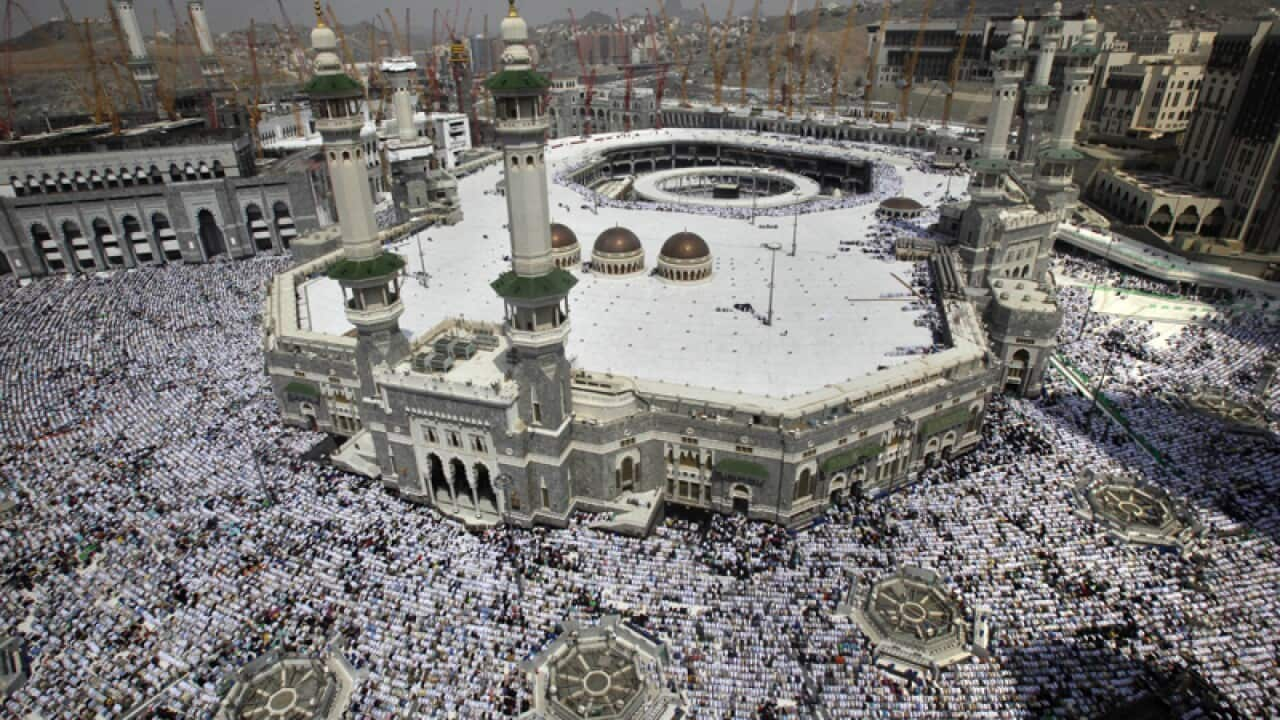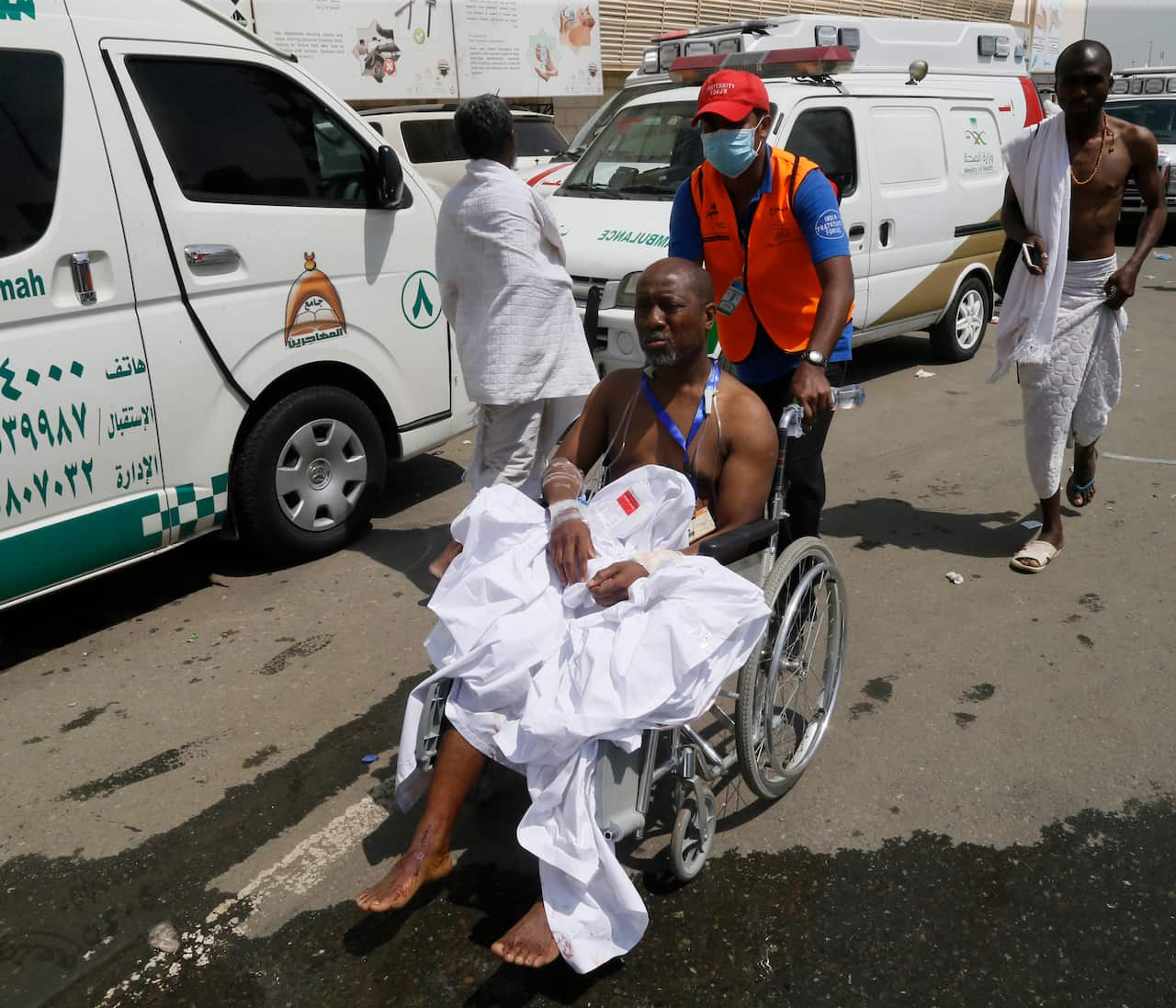At least 863 others were injured. Saudi King Salman said he had ordered a review of Hajjj plans after the disaster, in which two large groups of pilgrims arrived together at a crossroads in Mina, a few kilometers east of Mecca, on their way to performing the "stoning of the devil" ritual at Jamarat.
Related reading

What is Hajj and why do people go on the pilgrimage?
Thursday's disaster was the worst to occur at the pilgrimage since July 1990, when 1,426 pilgrims suffocated in a tunnel near Mecca. Both incidents occurred on Eid al-Adha (Feast of the Sacrifice), Islam's most important feast and the day of the stoning ritual.
No Aussies among Hajj dead: DFAT
No Australians are believed to be among the hundreds of casualties of the deadly stampede at the annual hajj pilgrimage.
But the Department of Foreign Affairs and Trade says it will continue checking with Saudi Arabian authorities for any updates on Australians potentially among the 717 pilgrims who died and 863 others wounded in the crush.
"At this stage no Australians have been affected by this tragedy," the department told AAP in a statement.
Photographs published on the Twitter feed of Saudi civil defense on Thursday showed pilgrims lying on stretchers while emergency workers in high-visibility jackets lifted them into an ambulance.
Other images showed bodies of men in white Hajjj garments piled on top of each other. Some corpses bore visible injuries.
Unverified video posted on Twitter showed pilgrims and rescue workers trying to revive some victims.
The Hajjj, the world's largest annual gathering of people, has been the scene of numerous deadly stampedes, fires and riots in the past, but their frequency has been greatly reduced in recent years as the government spent billions of dollars upgrading and expanding Hajjj infrastructure and crowd control technology.
Safety during Hajjj is a politically sensitive issue for the kingdom's ruling Al Saud dynasty, which presents itself internationally as the guardian of orthodox Islam and custodian of its holiest places in Mecca and Medina.

A rescue worker attends to a man injured in Mina, Saudi Arabia during the annual hajj pilgrimage on Thursday, Sept. 24, 2015. (AP Photo) Source: AAP
'Mismanagement and improper actions have caused this catastrophe'
Iran's Supreme Leader, Ayatollah Ali Khamenei, said the Saudi government should accept responsibility for the crush, in which more than 100 Iranian nationals were reported to have died.
"The Saudi government should accept the responsibility of this sorrowful incident ... Mismanagement and improper actions have caused this catastrophe," Khamenei said in a statement published on his website.
King Salman offered deep condolences.
"We have instructed concerned authorities to review the operations plan ... (and) to raise the level of organization and management to ensure that the guests of God perform their rituals in comfort and ease," the monarch said.
The Interior Ministry spokesman, Mansour Turki, said the investigation would look into what caused an unusual mass of pilgrims to congregate at the location of the disaster. "The reason for that is not known yet," he told a news conference in Mina.
Speaking in New York, Pope Francis expressed "my sentiments of closeness" with the world's Muslims after the tragedy.
UN Secretary General Ban Ki-moon and the United States offered condolences.
"The United States expresses its deepest condolences to the families of the hundreds of Hajjj pilgrims killed and hundreds more injured in the heartbreaking stampede in Mina, Kingdom of Saudi Arabia," White House spokesman Ned Price said.
Iran's Tasnim and Fars news agencies reported that 125 Iranians were among the dead. Fars reported that Tehran summoned the Saudi charge d'affaires to lodge an official complaint over the disaster.
Indonesian President Joko Widodo, who leads the world's most populous Muslim nation, said in a tweet from his official Twitter account late on Thursday that "there must be improvements in the management of the Hajjj so that this incident is not repeated".
South African acting President Cyril Ramaphosa extended condolences to families of the victims and said his government was awaiting information about his country's pilgrims.
Jamarat
Street 204, where the crush occurred, is one of two main arteries leading through the camp at Mina to Jamarat, the site where pilgrims ritually stone the devil by hurling pebbles at three large pillars. In 2006, at least 346 pilgrims died in a stampede at Jamarat.
"Work is under way to separate large groups of people and direct pilgrims to alternative routes," the Saudi Civil Defense said on its Twitter account.
It said more than 220 ambulances and 4,000 rescue workers had been sent to help the injured. Some of the wounded were evacuated by helicopters.
An Arab pilgrim who did not want to give his name said he had hoped to perform the stoning ritual later on Thursday afternoon but was now too frightened to risk doing so.
"I am very tired already and after this I can't go. I will wait for the night and if it not resolved, I will see if maybe somebody else can do it on my behalf," he said.
Efforts to improve safety at Jamarat have included enlarging the three pillars and constructing a three-decker bridge around them to increase the area and number of entry and exit points for pilgrims to perform the ritual.
More than 100,000 police and thousands of video cameras are also deployed to allow groups to be dispersed before they reach dangerous levels of density.
Two weeks ago, 110 people died in Mecca's Grand Mosque when a crane working on an expansion project collapsed during a storm and toppled off the roof into the main courtyard, crushing pilgrims underneath.
Share

